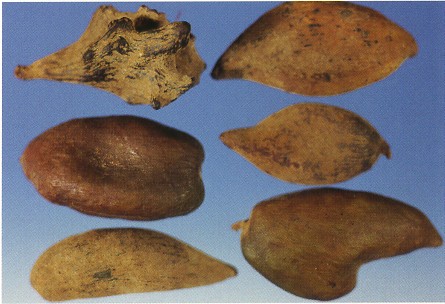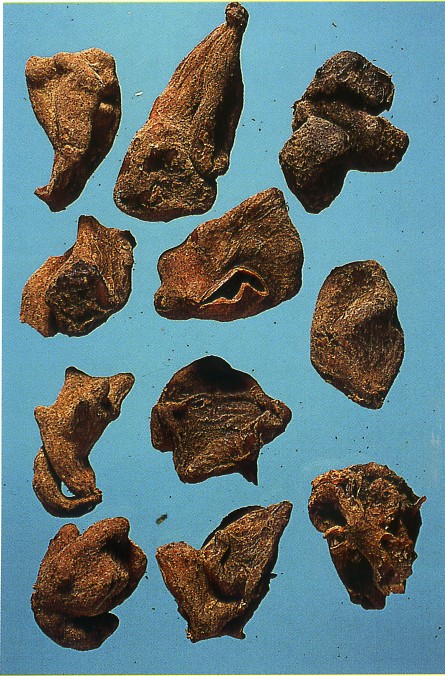| common name | Chinese Gall Wu Bei Zi |
This product is mainly the gall formed by the Rhus chinensis (Rhus chinensis Mill.) of the Anacardiaceae family after being infested by the aphid Melaphis chinensis (Melaphis chinensis (Bell) Baker) Chinese Taxillus Herb, known as "horned gall"; a small portion is the gall formed by the same genus plant Rhus punjabensis (Rhus punjabensis Stew. var. sinica (Diels) Rehd. et Wils. after being infested by the aphid Melaphis paitan (Melaphis paitan Tsai et Tang) Chinese Taxillus Herb, known as "belly gall". There are also galls formed by various other plants of the same genus after being infested by similar aphids Chinese Taxillus Herb.
This product was first recorded in the Tang dynasty's Bencao Shiyi, and is also documented in the Song dynasty's Kaibao Bencao, Tujing Bencao, and is included in the middle grade of the wood section in Zhenglei Bencao, and in the insect section of the Ming dynasty's Bencao Gangmu. Ma Zhi said: "Its seeds are green, the large ones are as big as a fist, and inside there are many insects." Su Song said: "The best ones are from Sichuan, growing on the leaves of the Rhus tree." Li Shi-zhen said: "This tree grows in clusters, in the fifth and sixth months, small insects like ants feed on its sap, and when they age, they leave their offspring to form small balls between the leaves... initially very small, gradually growing hard, as big as a fist, or as small as a water caltrop base peel, varying in shape from round to long, initially green, turning fine yellow over time, hanging on branches and leaves, as if naturally formed; its shell is hard and brittle, hollow inside, with tiny insects like midges. Mountain people collect them before Frost's Descent (18th solar term), steam them to kill the insects, otherwise the insects will bore through and the shell will become thin and rotten, tanners use them to make white medicine decoction, for dyeing dark colors, widely used at the time." Thus, the product used in ancient and modern times is the same.
bubble_chart Morphological Characteristics


bubble_chart Properties and Meridians
Sour and astrient, cold. Act on lung, large intestine and kidney meridians.
Astringing the lungs and reducing fire, astringing the intestines and checking diarrhea, consolidating essence and stopping seminal emission, astringing sweat and stopping bleeding.
- Used for lung deficiency chronic cough disease or lung heat phlegm cough: This product is sour and astringent, cold in nature to clear heat, capable of astringing the lung and relieving cough, and also has the function of clearing heat and purging fire. For treating lung deficiency chronic cough disease, it is often used with Schisandra Fruit, Poppy Capsule, and other astringing lung and relieving cough medicines; for treating lung heat phlegm cough, it can be used with Trichosanthis Fruit, Skullcap Root, Fritillaria Bulb, and other heat-clearing and phlegm-resolving medicines.
- Used for chronic diarrhea, long-term dysentery: Chinese Gall has the effect of astringing intestines and checking diarrhea. For treating the above symptoms, it can be used with Chebula Fruit, Schisandra Fruit to enhance the effect of astringing intestines and checking diarrhea.
- Used for seminal emission, spermatorrhea: This product can also astringe and consolidate essence to stop emission, used for kidney deficiency seminal emission, spermatorrhea, often used with Fossil Bone, Poria, etc., such as Hejiju Fang Yusuodan.
- Used for spontaneous sweating, night sweat: Chinese Gall can astringe the lung and stop sweating, can be used alone by grinding into powder, mixed with buckwheat flour in equal parts to make cakes, baked and eaten; or ground into powder and mixed with water to apply on the navel.
- Used for menorrhagia and metrostaxis bleeding or bloody stool hemorrhoid bleeding: This product has the effect of astringing and stopping bleeding. For treating menorrhagia and metrostaxis bleeding, it can be used alone, or with carbonized windmill-palm petiole, Carbonized Human Hair, etc.; for treating bloody stool hemorrhoid bleeding, it can be used with Sophora Flower, Sanguisorba, etc., or decocted for fumigation and washing the affected area.
- In addition, this product also has the effects of removing toxin, reducing swelling, drying dampness, astringing sores, and stopping bleeding when used externally, and can be used for boils and sores, eczema with water from river, unhealed ulcers, prolapsed anus, prolapsed uterus, etc. It can be used alone by grinding into powder for external application or decocted for fumigation and washing, or used in combination with alum.
- Bencao Shiyi: "For intestinal deficiency with diarrhea and dysentery, take it as a powder with hot water."
- Bencao Gangmu: "Astringes the lungs, reduces fire, resolves phlegm, stops cough, consumptive thirst, night sweat, vomiting, loss of blood, chronic dysentery... Treats red and ulcerated eyes, reduces swelling and toxicity, pharyngitis, astringes ulcers and incised wounds, and treats prolapse of the rectum and uterine prolapse." Also, "Its taste is sour and salty, capable of astringing the lungs and stopping bleeding, resolving phlegm, quenching thirst, and stopping sweating; its nature is cold, capable of dispersing heat toxins, swelling, and sores; its property is astringent, capable of eliminating diarrhea, dysentery, and damp ulceration."
Dosage: 1.5-6g, used in pills or powders. For external use, an appropriate amount is decocted for fumigation and washing or ground into powder for sprinkling.
bubble_chart Cautions and Contraindications
Cough due to external contraction and diarrhea caused by dampness-heat should be avoided.
bubble_chart Modern Pharmacology
This product mainly contains 60-70% Nutgall tannin, 2-4% Nutgall acid, as well as resin, fat, wax, starch, etc.
Nutgall acid has a protein-precipitating effect. When it comes into contact with the ulcerated surface of the skin or mucous membrane, the tissue proteins coagulate, forming a protective membrane and exhibiting an astringent effect. The coagulation of glandular cell proteins leads to secretion, resulting in the drying of the mucous membrane. The precipitation of proteins in nerve endings can cause a mild local anesthetic effect. Nutgall acid can form insoluble compounds with certain metals and alkaloid glycosides, thus serving as a detoxifying agent. Nutgall has an astringent effect on the small intestine, reducing intestinal inflammation and stopping diarrhea. Additionally, it inhibits Staphylococcus aureus, Streptococcus, Pneumococcus, cold-damage disease, paracold-damage disease, dysentery, anthrax, diphtheria, and Pseudomonas aeruginosa.
- Astringent effect: This product exhibits the general pharmacological effects of tannins. Tannins have a protein-precipitating effect, causing the coagulation of proteins in local tissues such as the skin, mucous membrane, and ulcerated surfaces, thus showing an astringent effect. Clinically, it is used to treat internal hemorrhoids and cervical erosion. Tannins can form insoluble compounds with certain heavy metals, alkaloids, or glycosides, making them useful for detoxification.
- Antibacterial effect: This product has a strong broad-spectrum antibacterial effect. In vitro tests have shown that Chinese Gall decoction significantly inhibits Staphylococcus aureus, beta-hemolytic Streptococcus, Pneumococcus, as well as cold-damage disease, dysentery, anthrax, diphtheria, Proteus, Pseudomonas aeruginosa, Microsporum canis, Trichophyton rubrum, and Cryptococcus neoformans. The inhibitory effect on Pseudomonas aeruginosa and Shigella smithii is particularly strong. The antibacterial effect of Chinese Gall is related to its tannin content.
- Toxicity: Mice injected intraperitoneally with 100% Chinese Gall decoction at 0.25ml all died within 12 hours. When the dose was reduced to one-tenth of the original dose, no deaths or toxic reactions occurred. Guinea pigs orally administered 20g/kg of the decoction showed no abnormalities; however, after subcutaneous injection, local decay and necrosis occurred, with the animals exhibiting restlessness, sluggish movement, lethargy, poor appetite, and rapid breathing, leading to death within 24 hours. Tannins are almost entirely decomposed into gallic acid (Nutgall acid) and pyrogallic acid (pyro Nutgall acid) upon entering the body, and extremely high doses can cause focal liver cell necrosis.
- Gallic acid (Nutgall acid) and its esters can inhibit the contraction of bradykinin on the ileum of guinea pigs.
bubble_chart Other Related Items




